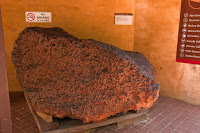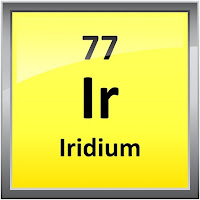Located in Group 6 and Period 9 of the Periodic Table is one of elements that resists corrosion. This is Iridium.
First discovered in 1803 at the same time with the discovery of Osmium, which is discovered by a British Chemist called Smithson Tennant, and first isolated also by this British chemist called Smithson Tennant.
 |
| Pierre-François Chabaneau |
After he studied the Platinum, he thought that he might discover a new element. However, the results of Chabaneau puzzled him.
The result he got is that the Platinum he worked with could be hammered into thin sheets easily. At other times, it is brittle and shatters when hammered. He became very confuse and eventually didn't find anything.
However, what Chabaneau didn't realise is, that the ' Platinum ' he actually is working on is actually some other undiscovered Noble Metals ( Platinum, Osmium, Gold and others ).
In the early 1800s, many chemists start to try to isolate new elements in the Platinum metals. They were not successful.
 |
| Smithson Tennant |
 |
| The Black Powder Smithson found |
He took the black powder for investigation. He discovered that the black powder doesn't have the same properties with Platinum. Until this point, he only realized that he discovered a new element. He named it Iridium, named after the Greek Rainbow Goddess named Iris.
Now, everyone knows that dinosaurs actually had gone extinct. However, everyone was still eager to know how they got extinct? It was believed to be volcano eruption, meteorite struck to earth and many other reasons. Now, the reasons scientist predicted the meteorite struck on earth because some scientist found an unusually many Iridium in a place.
 |
| An artist's illustration about how dinosaur looked like when the meteorite struck Earth |
 |
| Meteorite Sample |
Iridium is very rare, that only 2 parts per billion of Iridium only exists in the Earth's Crust. Interestingly, there are 3 parts per million of Iridium in Iron Meteorites, and 0.64 parts per million of Iridium containing in Stony Meteorites.
There is no currently harm of eating Iridium. Other life threatening risks is also not studied by scientist because Iridium is so rare that it is thought no one might eat it.
Atomic Number : 77
Name : Iridium
Latin Name :Iridium
Electrons per shell : [ 2, 8, 18, 32, 15, 2 ]
Discoverer : Smithson Tennant ( 1803 )
Isolator : Smithson Tennant ( 1803 )
Element's : Atomic Mass : 192.217 u
: Density : 22.56 g/cm3
: Type : Transition Metals
Chemical Properties :
 |
| Iridium - 192 |
- Almost Unreactive in room temperatures
- Forms Iridium Dioxide when combined with oxygen
- 74 isotopes : 3 of them are :
Iridium - 191 : Protons : 77
: Neutrons : 114
: Electrons : 77
( Half Life : Stable )
Iridium - 192 : Protons : 77
: Neutrons : 115
: Electrons : 77
( Half Life : 73.827 days )
Iridium - 193 : Protons : 77
: Neutrons : 116
: Electrons : 77
( Half Life : Stable )
Physical Properties :
- Silvery - white color
- Breaks instead of Bending
- Ductile
- Melting Point : 2443 degrees Celsius ( 4429 Fahrenheit )
- Boiling Point : 4500 degrees Celsius ( 8130 Fahrenheit )
How Iridium got its name?
 |
| The goddess Iris |
Uses
Iridium is mainly used in alloying. Iridium is often combined with Platinum, mainly to provide stronger material than Platinum. These alloys are very expensive. So, this alloy is only used in Helicopter's Spark plug. This type of Alloy is also used in electrical contacts, special types of electric wires and electrodes.
 |
| Helicopter's Spark Plug |
THIS IS THE END OF TUNGSTEN
To go to homepage, click this link :
To go to Chemistry Element Page, click this link :
Thanks for visiting.
If there is any improvements needed, feel free to comment at the comment section below.
Thank you.
If there is any improvements needed, feel free to comment at the comment section below.
Thank you.

